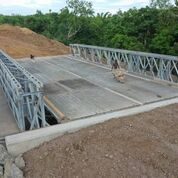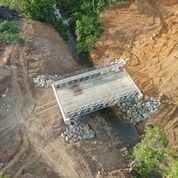Hot-Dip Galvanized Steel Skips the “Grave” as a Cradle to Cradle Material
Sustainable development has been a part of construction for many years, and as we enter into a new decade, one synonymous with perfect vision, it only seems appropriate that sustainability is more in focus. One of the biggest tenets within sustainability is recyclability. As the interest in sustainable development grew, so to did companies explaining the recyclability and recycled content in their products. It is easy to understand how recycling benefits future generations, but as we move into 2020, it is time to think beyond the simplest forms of recyclability.
When it comes to sustainable development, you’ve probably heard of the concept of “cradle-to-grave.” This term is often used when discussing life-cycle analysis – looking at the total environmental impact of a material from raw material acquisition to end of life. If you are familiar with the steel industry, you have also likely heard the term “cradle-to-cradle” as steel is infinitely recyclable, eliminating a “grave” for the material.
Like steel, zinc is 100% recyclable without the loss of any properties. This means both steel and zinc can be used over and over again as steel and zinc, not downcycled into a lesser product. This in and of itself is a great sustainable aspect of hot-dip galvanized steel. But once you look a little deeper, you will see the recyclability is only the tip of the iceberg when it comes to the sustainability of hot-dip galvanized steel.

The American Galvanizers Association (AGA) typically highlights three major environmental advantages when discussing the sustainability of hot-dip galvanized steel:
- Natural, Abundant Elements (zinc and iron)
- 100% Recyclability (zinc and steel)
- Maintenance-Free Longevity reducing the overall environmental impact
Here’s a quick summary of those baseline advantages. Hot-dip galvanized steel is made of natural, abundant elements – zinc and iron. Iron is the 4th most abundant element in Earth’s crust, and zinc is the 24th, and both are naturally found in our environment and essential to life. More important than their abundance, both steel and zinc are 100% recyclable without the loss of properties, creating an infinitely renewable resource. Finally, the maintenance-free longevity of hot-dip galvanizing reduces the need for energy and raw material input as well as emissions output throughout its life, reducing the overall impact to the environment.
So, now that we all have a baseline understanding of the intrinsic sustainability of hot-dip galvanized steel, let’s look below the surface and see what other advantages it provides. When a hot-dip galvanized steel project has reached the end of its use, there are a number of options for the material to be reused. The first, as already discussed is recycling through reprocessing. An important note here is many materials have the ability to be recycled, but it is also important to consider their reclamation rate – the amount of the material available for recycling that is actually reprocessed. In the case of hot-dip galvanized steel, the reclamation rate is high. Virtually 100% of all steel is reclaimed, and 80% of zinc, so recycling isn’t just possible, it is the standard of practice in our industry.

However, before going straight to reprocessing, there are two other options that ought to be considered. The first is often called “strip and redip,” which is taking a piece of steel (whether initially painted or galvanized) and stripping the coating off, cleaning, and then dipping in the molten zinc to create a newly galvanized part. This reduces environmental impact by avoiding reprocessing to raw materials and then having to fabricate new steel elements. Instead, the existing steel elements are recoated and reinstalled, such as was done in these projects (among others): Michigan/M-102 Bridge Rail Reconstruction, Bridges of Stark County, andPlayland’s Castaway Cove Ferris Wheel.
Beyond recycling and “strip and redip,” hot-dip galvanized steel provides the opportunity to simply reuse the steel without reprocessing of any kind. As noted above, hot-dip galvanized steel provides maintenance-free longevity – 70 years or more in atmospheric exposure. Therefore, it is possible the life of the initial structure using hot-dip galvanized steel is less than the life of the coating. In that instance, the hot-dip galvanized steel components can be moved from one project location to another, such as the case of the Riviere Cochon Gras Bridge. The bridge in Perches, Haiti was made from hot-dip galvanized truss that was previously installed in Quincy, MA for 15 years as the Fore River Bridge.
Hot-dip galvanized steel’s ability to be reused, redipped, or recycled provides versatility for future generations. Not only are these more environmentally friendly, but they also lead to economic savings. As we continue with our “2020 vision,” let’s continue to strive to move the needle forward when it comes to sustainable development. Hot-dip galvanized steel provides intrinsic sustainable benefits – natural, abundant elements, 100% recyclability, and maintenance-free longevity. The flexibility to reuse, redip or reclaim truly eliminates any “grave” for hot-dip galvanized steel, allowing it to transcend time and improve the quality of life today and in the future.

